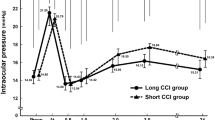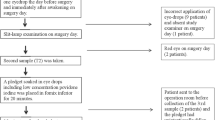Abstract
The purpose of this work was to study the incidence of clear corneal wound leakage at the conclusion of standard co-axial phacoemulsification in a prospective observational series of 100 consecutive cataract cases in a single surgeon’s institutional practice. At the conclusion of standard co-axial phacoemulsification using a 2.75 mm temporal single plane clear corneal incision with a 1 mm clear corneal side-port incision, the wounds were hydrated and checked for water-tightness. Povidone iodine 5% (P-I) was then evenly dripped over the cornea and the wounds were inspected visually. Any leakage of aqueous observed was recorded. The amount of leakage was graded as small or large from each wound. Leaky wounds were further hydrated and retested with P-I until sealed. Wound integrity was reassessed on the first postoperative day by use of fluorescein. Of the 100 cases, wound leakage was observed for 31 eyes (31%)—ten main incisions, nineteen side-port incisions, and both incisions in two cases. Wound leakage was easily detected as a ribbon of clear fluid streaming from the incision amid a pool of brown solution. Povidone iodine was not observed within the tract in any incision. All wound leakage was small except for one from the main incision and two from the side-port incision. None of the eyes developed wound leakage the day after surgery and none developed endophthalmitis. In conclusion, leakage from clear corneal incisions at the conclusion of phacoemulsification occurs in almost a third of cases, predominantly from the side incision. It is easily detected by use of the P-I test.

Similar content being viewed by others
Abbreviations
- AC:
-
Anterior chamber
- BSS:
-
Balanced salt solution
- P-I:
-
Povidone iodine 5%
References
Leaming DV (2002) Practice styles and preferences of ASCRS members-survey 2001. J Cataract Refract Surg 28:1681–1688
Lyle WA, Jin GJ (1996) Prospective evaluation of early visual and refractive effects with small clear corneal incision for cataract surgery. J Cataract Refract Surg 22:1456–1460
Cooper BA, Holekamp NM, Bohigan G et al (2003) Case-control study of endophthalmitis after cataract surgery comparing scleral tunnel and clear corneal wounds. Am J Ophthalmol 136:300–305
Nagaki Y, Hayasaka S, Kadoi C et al (2003) Bacterial endophthalmitis after small-incision cataract surgery. Effect of incision placement and intraocular lens type. J Cataract Refract Surg 29:20–26
Taban M, Sarayba MA, Ignacio TS et al (2005) Ingress of India Ink into the anterior chamber through sutureless clear corneal cataract wounds. Arch Ophthalmol 123:643–648
Srinivasan R, Tiroumal S, Kanungo R et al (2002) Microbial contamination of the anterior chamber during phacoemulsification. J Cataract Refract Surg 28:2173–2176
McDonnell PJ, Taban M, Sarayba M et al (2003) Dynamic morphology of clear corneal cataract incisions. Ophthalmology 110:2342–2348
Wallin T, Parker J, Jin Y et al (2005) Cohort study of 27 cases of endophthalmitis at a single institution. J Cataract Refract Surg 31:735–741
Ernest PH, Lavery KT, Kiessling LC (1994) Relative strength of scleral corneal and clear corneal incisions constructed in cadaver eyes. J Cataract Refract Surg 20:626–629
Author information
Authors and Affiliations
Corresponding author
Rights and permissions
About this article
Cite this article
Chee, SP. Clear corneal incision leakage after phacoemulsification––detection using povidone iodine 5%. Int Ophthalmol 26, 175–179 (2005). https://doi.org/10.1007/s10792-007-9031-3
Received:
Accepted:
Published:
Issue Date:
DOI: https://doi.org/10.1007/s10792-007-9031-3




